tags: London England, Ye Olde Cheshire Cheese, Dickens, photoessay, travel
Entrance to Ye Olde Cheshire Cheese, one of the oldest pubs in London.
There is a sign to the right of the entrance that names all the kings and
queens who reigned during this pub's existence.
Image: GrrlScientist, 1 September 2008 [larger view].
The day after Nature's European ScienceBlogging Conference had ended (I am still working on those photoessays and blog entries), I set out with my friend and colleague, Bob O'Hara, to photograph London and then to attend a play at the Globe Shakespeare Theatre. This photoessay shows some of the buildings I photographed, and the pub I visited for lunch: Ye Olde Cheshire Cheese.
I love oddly shaped buildings, which explains my particular fondness for NYC's Flatiron Building. But while I was walking around London, I saw this cute little triangular building, the Black Friar Pub, which is vaguely reminiscent of the Flatiron. This pub is located near the Blackfriars Bridge and St. Paul's Cathedral (where Diana married Prince Charles) on Queen Victoria Street in London;
Thanks to a reader, the below building has been identified as the Cathedral Church of Paul the Apostle, or more commonly as St. Paul's Cathedral, which has stood on this site since 604AD. St Paul's Cathedral is an Anglican cathedral and is the seat of the Bishop of London. This cathedral sits on Ludgate Hill, located on the edge of London's oldest region, "The City" of Londonium, which originated as a Roman trading post along the edge of the River Thames.
The building that I photographed is actually the fifth Cathedral to occupy this site. This cathedral was designed by the court architect Sir Christopher Wren (who seems to have designed most of the important buildings in London during this time) and was constructed between 1675 and 1710 to replace the previous building, which was destroyed in the Great Fire of London. [read more about St. Paul's Cathedral].
Unfortunately, I did not go inside but thanks to Wikipedia, here is a picture of the interior of St. Paul's Cathedral taken shortly before Christmas 2004, facing east;
Again, thanks to a reader, the correct identification of the image below is a steeple of St. Nicholas Cole Abbey, a church located on Queen Victoria Street that dates from the twelfth century. Like St. Paul's Cathedral, this church was destroyed in the Great Fire of London in 1666 and it was later rebuilt by the amazing Sir Christopher Wren. During World War Two, this church suffered substantial bomb damage and was reconstructed by Arthur Bailey between 1961-1962.
St Nicholas of Myra, for whom the church is named, is a 4th century patron saint of children and fishermen, which this church has apparently helped in times of need throughout history [Read more about St. Nicholas Cole Abbey].
Steeple, St. Nicholas Cole Abbey, London, England.
Image: GrrlScientist, 1 September 2008 [larger view].
I am especially proud of this steeple image because the pale color and strong angles of the building contrast so powerfully with the intense blue of the sky and the soft irregularity of the clouds.
I have spent literally hours trying to discover the identity of this building (below), but have been unable to do so. Thanks to a reader, this building, which has no formal name, is a group of very nice apartments;
Unidentified round glass apartment building with (no doubt) sky-high rents.
Image: GrrlScientist, 1 September 2008 [larger view].
Anyway, after a morning of walking around and photographing buildings, Bob and I were thirsty and hungry, so we went in search of a pub to refresh ourselves in. Ever since I learned of Ye Olde Cheshire Cheese, I was determined to visit this old London pub, so I made a special effort to find this place and to have lunch there. This is the gloomy and narrow passageway leading to Ye Olde Cheshire Cheese;
The gloomy and narrow passageway leading to Ye Olde Cheshire Cheese.
Image: GrrlScientist, 1 September 2008 [larger view].
According to my sources, Ye Olde Cheshire Cheese is one of a number of pubs in London that were rebuilt shortly after the Great Fire of 1666. There has been a pub at this location since 1538.
Ye Olde Cheshire Cheese is a really peculiar pub by American standards; there are many smaller bars and dining rooms within this building, each connected by a maze of narrow, twisting passageways and stairways with very low ceilings. Oddly, the rooms have incredibly high vaulted ceilings that are supposed to be part of the original building, which was a 13th century Carmelite monastery. This pub relies exclusively on ambient light coming into its small windows; I can only imagine what this place looks on a stormy winter night, and how the patrons become lost when trying to find or return from the bathrooms.
Inside one of the many smaller pubs within Ye Olde Cheshire Cheese
(flash photography).
Image: GrrlScientist, 1 September 2008 [larger view].
Ye Olde Cheshire Cheese is, without a doubt, the darkest pub I've ever been in. Nevertheless, despite its gloom, we ate a nice lunch and had a few pints of the local brews while we were there. It was very pleasant.
Before we left, I had to see and photograph Charles Dickens' favorite place to sit in the pub's main floor restaurant. According to legend, Dickens sat next to the fireplace while he dined on Welsh rabbit and drank the local beers (legend does not reveal what he talked about, though);
A bronze plaque marks Charles Dickens' favorite place to sit in London's Ye Olde Cheshire Cheese.
Image: GrrlScientist, 1 September 2008 [larger view].
Of course, I sat in his favorite seat, too -- how could I resist?
For those of you who read English literature, you will realize that Ye Olde Cheshire Cheese Pub is referred to in Dickens's A Tale of Two Cities. [Read more about Ye Olde Cheshire Cheese].
After we left the pub, Bob and I walked across the Millennium Footbridge to visit the Tate Modern Art Gallery. Below is an aerial view of this lovely bridge, depicting it leading to the Tate Modern Art Galleries, which is that large, dark brick building with the tall tower (image thanks to Wikipedia);
Millennium Footbridge leading towards the Tate Modern. The round white building on the left side is the Globe Theatre, where we went later that evening to see a play.
Below is a photograph of Blackfriars Railway Bridge (you can even see a train on it) spanning London's River Thames that I photographed while standing on the Millennium Footbridge. Immediately on the other side of that bridge is the Blackfriars Bridge, which is open to both vehicle and pedestrian traffic. Between the two Blackfriars Bridges are the supports for the original bridge that was dismantled in 1985 after it became too weak to hold modern trains. The only thing remaining of the original bridge are the support columns, which are favored perches for a group of little gulls, Larus minutus, black-headed gulls, Chroicocephalus ridibundus, and common (mew) gulls, Larus canus, that I added to my London bird list.
Blackfriars Railway Bridge over the River Thames, London England.
Photographed from the Millennium Footbridge.
Image: GrrlScientist, 1 September 2008 [larger view].
Bob and I visited the Tate Modern Gallery and saw the Mark Rothko exhibit. Even though several of Rothko's exhibited paintings were big and colorful, and therefore vaguely appealing to me, I am not a big fan of his work, and I doubt Bob is, either (but I'll let him speak for himself on that point).
Below is one of the galleries that we visited (image thanks to Wikipedia: the gallery did not allow photography);
The Tate Modern is housed in the Bankside power station that was refurbished and opened in 2000, specifically for the purpose of displaying the British national collection of international modern art -- art that they defined as "modern" if it was been created since 1900.
After we left the Tate Modern, Bob and I stopped at a little coffee shop with outdoor seating in a paved plaza out front and drank some coffee. I was so amused by this large orange sign, which reads "Temporary Eyesore", surrounding a construction site in front of this building that I had to photograph it for you;
Temporary Eyesore.
Unidentified building with amusing sign, London England.
Image: GrrlScientist, 1 September 2008 [larger view].
One of the many things that I learned as a result of my walking around London is that the British love their churches and cathedrals, and they are especially fond of round, pointy buildings. This contrasts strongly with NYC architecture, which prefers angular, pointy buildings. To say the least, I prefer London architecture.
Tomorrow, I will show you the photoessay of our Globe Theatre adventure.

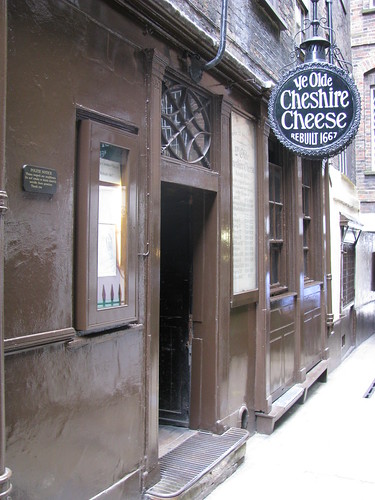

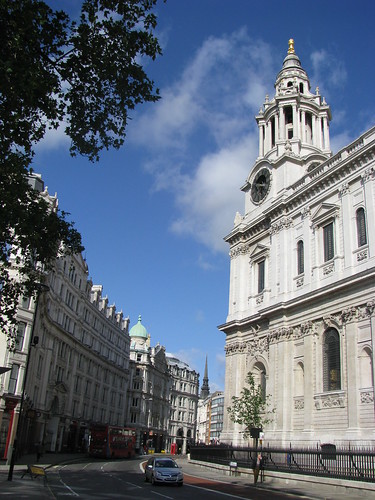
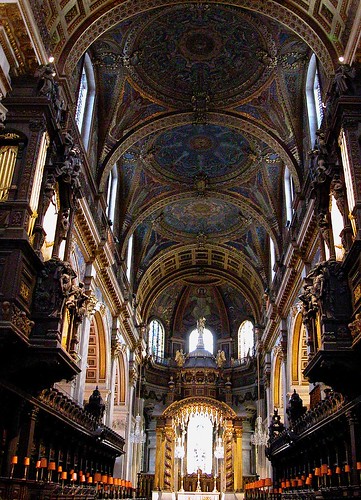
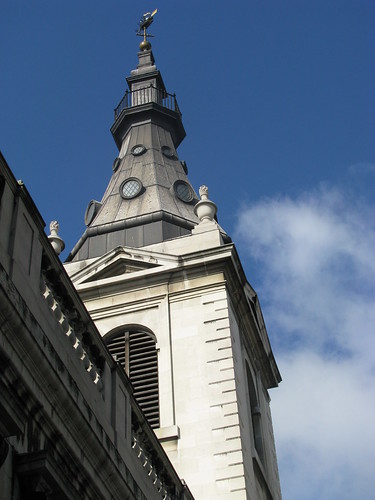
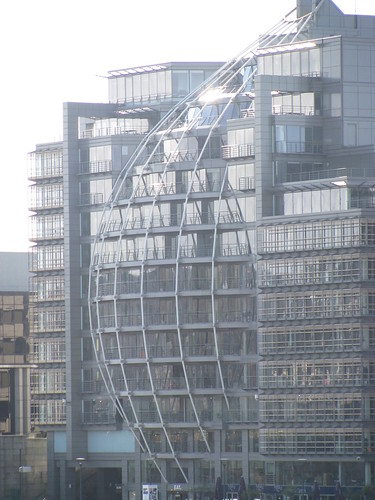

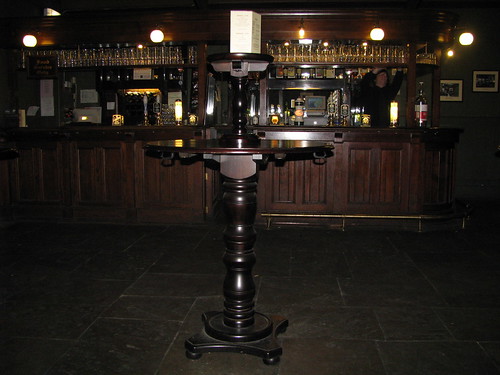
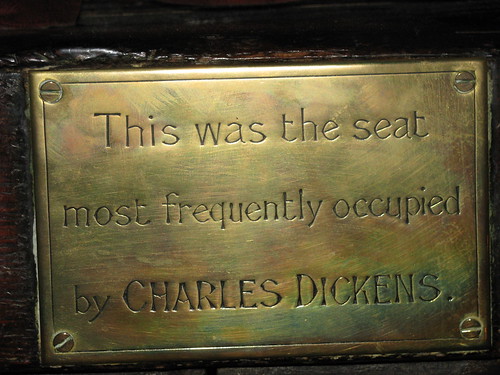
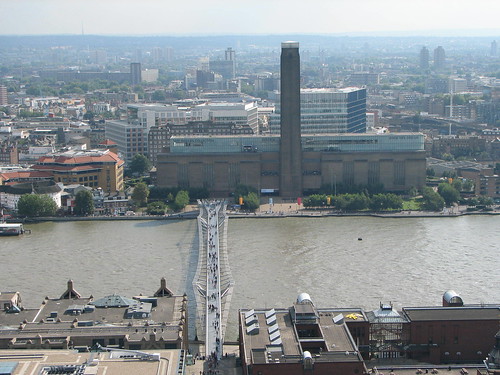
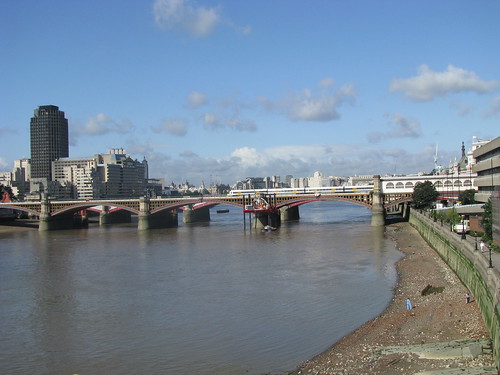
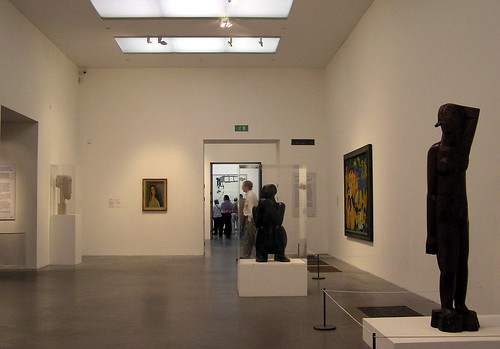

Yo. Great post. I've got a few corrections for your photo captions. (Sorry!)
The photo labelled 'Lodon's Inns of Court' is actually St Paul's Cathedral.
The 'Spire Law Courts' is actually a Christopher Wren church in the City. It's St Nicholas, Cole-Abbey
http://www.oldlondonmaps.com/viewspages/0315.html
The unidentified round glass building has no name that I know of - it's a block of (very nice) appartments.
Nice. I concur with M@, however, on the identity of the buildings he highlighted.
With regards to:
http://en.wikipedia.org/wiki/Image:Royal_courts_of_justice.jpg
these were actually built in around 1880, some 200 years after Wren built St. Paul's cathedral. However, I believe they both were built using the very distinctive Portland stone, which is possibly why the two might be confused.
thanks to both of you for your help! i entertained the thought that the upper building was St. Paul's cathedral, especially because I had wandered around this building, but remained unconvinced, but i had to give it some name for my photoessay! ( i knew that, if i was wrong, someone would correct me).
the unidentified building that you have a picture of which is mentioned by a reader to be apartments is sadly incorrect.
the building is owned by Ofcom (the communication regulator) but is also occupied, on its top 3 floors (of 12) by Broadway Malyan architects and (since March 2009) the Olympic Delivery Authority.
How do i know this. I worked there for 2 months. It was purpose built for Ofcom who have since let those top floors out, so it could never have been an apartment block. You got one thing right though: the rents are sky high!!